|

 Up
Up 
 Aviation's Attic
Aviation's Attic

(You are here.)
 Down
Down




  Need
to Need
to
find your
bearings?
Try
these
navigation aids:
If
this is your first
visit, please stop by:
Something
to share?
Please:



|
|
Available in Française, Español, Português, Deutsch, Россию,
中文,
日本, and others.
 istory
is an endless storehouse of treasures, and pioneer aviation is one of its
richest rooms. Small wonder that pilots like to spend hours "hangar
flying," sharing tale after tale . Any aviation story worth telling
is rich with adventure and discovery. After all, these are tales about men
and women who fly, a unique and awesome ability that mankind
has only developed in the last century. istory
is an endless storehouse of treasures, and pioneer aviation is one of its
richest rooms. Small wonder that pilots like to spend hours "hangar
flying," sharing tale after tale . Any aviation story worth telling
is rich with adventure and discovery. After all, these are tales about men
and women who fly, a unique and awesome ability that mankind
has only developed in the last century.
Part of our job at the Wright Brothers Aeroplane Company is to dig up
pioneer aviation stories, brush them off, and share them with you. In
doing so, we organize that information so that it presents a coherent
picture of the lives of the Wright brothers and the history of early
aviation. But we occasionally find unique and interesting treasures that
don't quite fit the categories we've developed. Rather than ignore
these odd gems, we've decided to bring them front and center. Here, then
are a few of the unique and precious oddities that we've discovered in the
far corners of aviation's attic.
|
|
|
|
Griffith Brewer learned to fly at the Wright
Flying School. He was an English balloonist and
patent attorney who knew Wilbur and Orville throughout
their entire aviation career. He met Wilbur in France in
1908, the two became fast friends, and Wilbur treated
him to an airplane ride, making him the first Briton
ever to fly in a powered airplane. A few months later,
he met Orville when the younger brother joined Wilbur in
France, and Brewer hit it off with the other Wright as
well. Later, Brewer organized the British Wright
Company, representing the Wright's interests in England.
He also traveled to Ohio -- thirty times in all -- to
visits the Wrights in Dayton. In this short piece, he describes his first visit to
Dayton, Ohio, sharing interesting details and insights
about the Wright factory, their flight school, and
life at the Wright home.
|
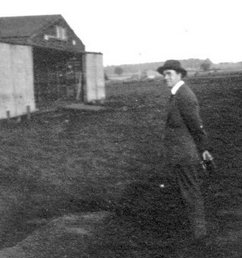
Griffith Brewer at Simms Station.
|
|
|
For nearly thirty years, Orville Wright and the
Smithsonian Institution were at loggerheads over who
invented the airplane. In 1914, Glenn Curtiss in
partnership with the Smithsonian, dusted off the 1903
Langley Aerodrome, updated it, and made a few
hop-flights. The Aerodrome was a manned aircraft
designed by the late Smithsonian secretary, Samuel P.
Langley, who tried and failed to fly it in 1903,
just before the Wright bothers made their first
successful flights. The Smithsonian, after Curtiss flew
a much-modified Aerodrome, claimed that the original
aircraft could have flown before the Wright Flyer and
that the Langley Aerodrome was in fact the first
aircraft "capable of flight." This set off a controversy
that nearly lost America one of its dearest national
treasures.
|
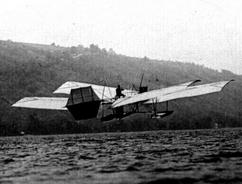
The modified 1903 Langley Aerodrome in flight near Hammondsport, NY,
17 September 1914.
|
|
|
Thanks to several generous souls, we have uncovered 14 vintage photos
of the Wrights and their first pupils flying at Huffman Prairie and in
Sedalia, Missouri. The photos document the period when the Wright
brothers had begun to question the stability and efficacy of their
distinctive "tail-first" or canard design. They show how Wright
pilots experimented with and
compared with front elevators, back elevators, and elevators in
both the front and back. They also capture the moment just before he
Wrights adopted the conventional aircraft configuration with the main
wings forward and the elevator and rudder in back, forming an empennage
or "tail." |
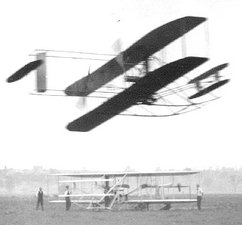
Flying the Wright Model AB.
|
|
|
In this article Fred Kelly, the Wright brothers' only "authorized"
biographer, examines the popular myth that the Wrights were secretive,
hiding their early aeronautical experiments from the eyes of the public.
Kelly makes a convincing argument that they were not. Instead, he
presents evidence that this was an excuse that American journalists
adopted to cover their embarrassment for having completely overlooked
the biggest story of the twentieth century. The truth of the matter was
that the American media – in fact, the world media – just couldn't
bring themselves to believe that men had flown.
|

The Virginian Pilot breaks
the news of the Wright's first flights.
|
|
|
In 1909, several aviation enthusiasts in England had Thomas
W. K. Clarke build an updated version of the 1902 Wright Glider that they
could use for training while waiting for their powered aircraft to
be built. With Orville Wright's input, Clarke came up with a cross between the 1902 glider and a
Wright Model A. This was possibly the first "flight trainer" ever
made. In 1910, Clark deigned and built three additional
biplane gliders, including one that he advertised as an update of the
1896 Chanute-Herring glider, one of the gliders that had inspired
the Wright brothers. You could buy a Clark glider as a kit for £10.50 or
fully assembled for £34.00. |
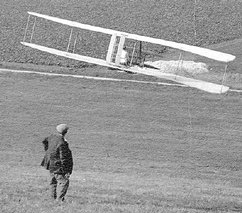
Flying a Wright glider in England.
|
|
The first woman journalist to become famous for her interviews
takes on Wilbur and Orville -- and shows a completely different side of
the brothers other than the sober persona they projected to the world.
Kate Carew (her real name was Mary Williams) had a playful interview
style that she used to put her subjects at ease. The Wright brothers
apparently anticipated the fun and went at her with some playful jibes
of their own. |
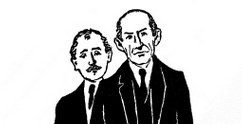
Carew also drew these caricatures of the brothers.
|
|
One of the most successful wheeler-dealers of all time -- the man who
created IBM -- remembers how difficult it was to sell the Wright
airplane. Flint is best remembered as the "father of trusts" -- he
invented the corporate conglomerate. He believed that smaller companies,
each with unique ideas and assents, could be combined to make large,
stronger, and more profitable organizations. He proved this by bringing
together companies to found U.S. Rubber (1892), American Woolen (1899)
and the company that would become International Business Machines
(1911).Flint also put together other famous deals, and perhaps his most
famous was the sale and licensing of the Wright airplane to investors in
Europe.
|
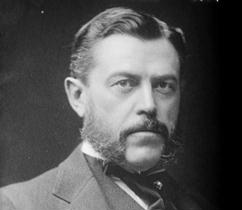
Charles Ranlett Flint.
|
|
It's amazing how many bad ideas a group of aeronautical engineers can
generate when they really put their minds to it. This was especially
true in the earliest days of aviation when no one really knew what an
airplane should look like. Over the years, we've collected a large
assortments of "flops" – aircraft built in the pioneer era of aviation
that never got off the ground. Some were simple constructions, some were
absurdly complex, some looked nothing at all like an airplane. They all
shared one common trait – the were intended to fly, but never did.
|
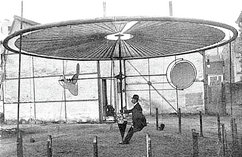
You can wind it up, but it won't take you anywhere.
|
|
A mail-order catalogue for the discerning 1912 pilot and
aircraft-builder – engines, tires, fitting, goggles, even plans for a
Bleriot XI – an amazing 20 pages of industrial aviation stuff from a
time when the aviation industry was only 3 years old! |
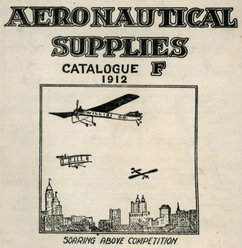
Great prices, too.
|
|
The newly formed Aero Club of America hosts a trade show in New York
City, showing the very latest in aviation equipment from both sides of
the Atlantic Ocean, including the crankshaft and flywheel from the
"fabled" Wright Flyer. This unique trade show, the first
of its kind in America, was a pivotal event for the Wright brothers and
American aviation. Although they did not attend personally, the show
started an important ball rolling. Before the show, there was little to
distinguish the Wrights from the dozens of scientists, entrepreneurs,
and crackpots who claimed they were close to solving the "flying
problem." But the show attracted the attention of some powerful men who,
after some investigation, found that the Wrights had indeed solved it.
|
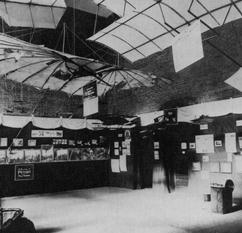
A turning point in American aviation.
|
|
|
|

